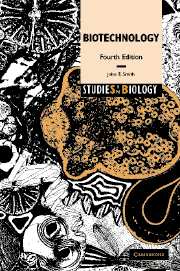Book contents
- Frontmatter
- Contents
- Preface
- 1 The nature of biotechnology
- 2 Substrates for biotechnology
- 3 Genetics and biotechnology
- 4 Bioprocess/fermentation technology
- 5 Enzyme technology
- 6 Biological fuel generation
- 7 Single cell protein (SCP)
- 8 Biotechnology and medicine
- 9 Environmental biotechnology
- 10 Biotechnology in the agricultural and forestry industries
- 11 Food and beverage biotechnology
- 12 Protection of biotechnological inventions
- 13 Safety in biotechnology
- 14 Public perception of biotechnology: genetic engineering – safety, social, moral and ethical considerations
- 15 Looking to the future
- Glossary
- Further reading
- Index
5 - Enzyme technology
Published online by Cambridge University Press: 05 June 2012
- Frontmatter
- Contents
- Preface
- 1 The nature of biotechnology
- 2 Substrates for biotechnology
- 3 Genetics and biotechnology
- 4 Bioprocess/fermentation technology
- 5 Enzyme technology
- 6 Biological fuel generation
- 7 Single cell protein (SCP)
- 8 Biotechnology and medicine
- 9 Environmental biotechnology
- 10 Biotechnology in the agricultural and forestry industries
- 11 Food and beverage biotechnology
- 12 Protection of biotechnological inventions
- 13 Safety in biotechnology
- 14 Public perception of biotechnology: genetic engineering – safety, social, moral and ethical considerations
- 15 Looking to the future
- Glossary
- Further reading
- Index
Summary
The nature of enzymes
Enzymes are complex organic molecules present in living cells where they act as catalysts in bringing about chemical changes in substances. With the development of the science of biochemistry has come a fuller understanding of the wide range of enzymes present in living cells and of their modes of action. Without enzymes, there can be no life. Although enzymes are only formed in living cells, many can be separated from the cells and can continue to function in vitro. This unique ability of enzymes to perform their specific chemical transformations in isolation has led to an ever-increasing use of enzymes in industrial and food processes, in bioremediation, and in medicine, and their production is collectively termed ‘enzyme technology’.
The activity of an enzyme is due to its catalytic nature. An enzyme carries out its activity without being consumed in the reaction, and the reaction occurs at a very much higher rate when the enzyme is present. Enzymes are highly specific and function only on designated types of compounds – the substrates. A minute amount of enzyme can react with a large amount of substrate. The catalytic function of the enzyme is due not only to its primary molecular structure but also to the intricate folding configuration of the whole enzyme molecule. It is this configuration which endows the protein with its specific catalytic function; disturb the configuration by, for example, a change in pH or temperature, and the activity can be lost.
- Type
- Chapter
- Information
- Biotechnology , pp. 76 - 101Publisher: Cambridge University PressPrint publication year: 2004



